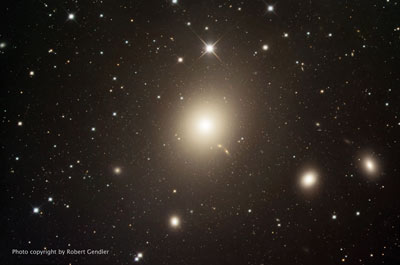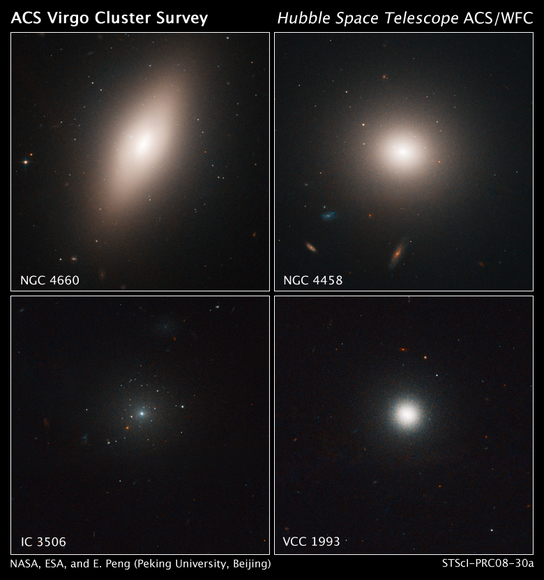[/caption]
Globular clusters are gravitationally bound, dense concentrations of stars. There can be hundreds of thousands of stars in a cluster, and they are so close together that it’s hard to distinguish globular clusters outside of our galaxy from stars within our own galaxy just using ground-based telescopes: in other words, these big bunches of far away stars can look like a single, nearby star. But astronomers recently used the Hubble Space Telescope’s sharp eyes to identify, incredibly, over 11,000 globular clusters in the Virgo cluster of galaxies. And in doing so, they also noticed something interesting about where the globulars are located. Globular clusters don’t seem to form uniformly from galaxy to galaxy; instead they like to be where the action is near the center of galaxy clusters. The globulars are also more prevalent in dwarf galaxies near the center of the cluster of galaxies.
Hubble’s Advanced Camera for Surveys resolved the star clusters in 100 galaxies of various sizes, shapes, and brightnesses, even in faint, dwarf galaxies. Comprised of over 2,000 galaxies, the Virgo cluster is the nearest large galaxy cluster to Earth, located about 54 million light-years away.
Astronomers have long known that the giant elliptical galaxy at the cluster’s center, M87, hosts a larger-than-predicted population of globular star clusters. The origin of so many globulars has been a long-standing mystery.
“Our study shows that the efficiency of star cluster formation depends on the environment,” said Patrick Cote of the Herzberg Institute of Astrophysics in Victoria, British Columbia. “Dwarf galaxies closest to Virgo’s crowded center contained more globular clusters than those farther away.”

The team found a bounty of globular clusters in most dwarf galaxies within 3 million light-years of the cluster’s center, where the giant elliptical galaxy M87 resides. The number of globulars in these dwarfs ranged from a few dozen to several dozen, but these numbers were surprisingly high for the low masses of the galaxies they inhabited. By contrast, dwarfs in the outskirts of the cluster had fewer globulars. Many of M87’s star clusters may have been snatched from smaller galaxies that ventured too close to it.
“We found few or no globular clusters in galaxies within 130,000 light-years from M87, suggesting the giant galaxy stripped the smaller ones of their star clusters,” explained Eric Peng of Peking University in Beijing, China, and lead author of the Hubble study. “These smaller galaxies are contributing to the buildup of M87.”
Hubble’s “eye” is so sharp that it was able to pick out the fuzzy globular clusters from stars in our galaxy and from faraway galaxies in the background. “With Hubble we were able to identify and study about 90 percent of the globular clusters in all our observed fields,” Peng said. “This was crucial for dwarf galaxies that have only a handful of star clusters.”
Evidence of M87’s galactic cannibalism comes from an analysis of the globular clusters’ composition. “In M87 there are three times as many globulars deficient in heavy elements, such as iron, than globulars rich in those elements,” Peng said. “This suggests that many of these ‘metal-poor’ star clusters may have been stolen from nearby dwarf galaxies, which also contain globulars deficient in heavy elements.”
Studying globular star clusters is critical to understanding the early, intense star-forming episodes that mark galaxy formation. They are known to reside in all but the faintest of galaxies.
“Star formation near the core of Virgo is very intense and occurs in a small volume over a short amount of time,” Peng noted. “It may be more rapid and more efficient than star formation in the outskirts. The high star-formation rate may be driven by the gravitational collapse of dark matter, an invisible form of matter, which is denser and collapses sooner near the cluster’s center. M87 sits at the center of a large concentration of dark matter, and all of these globulars near the center probably formed early in the history of the Virgo cluster.”
The fewer number of globular clusters in dwarf galaxies farther away from the center may be due to the masses of the star clusters that formed, Peng said. “Star formation farther away from the central region was not as robust, which may have produced only less massive star clusters that dissipated over time,” he explained.
Original News Source: HubbleSite Press Release


This is not at all surprising. M87 likely grew so big as a result of many mergers. The globular clusters likely represent what is left of galaxies eaten by M87. The gas was stripped away and the clusters is what remains of these smaller galaxies.
As I understand it, the globulars are not little pieces of a smashed galaxy left over from a gravitational disturbance by a big galaxy. Rather, the globular clusters tend to stay intact and are stolen by bigger galaxies from smaller galaxies. Kind of like a big bully stealing marbles from all the little kids.
At least I think that’s how it works…
Interesting analogy – helps me understand what’s going on a little better.
Thanks
Greg,
If gravity can strip away the gas (tenuous?), why does it leave the heavy stuff in place?
any word on omega cen? glob or dwarf galaxy?
Dwarf galaxy stripped of its outer stars.
http://arxiv.org/abs/0801.2782
Considering dark matter and energy. Could this not be the material and energy that happens between the time the light of any given object leaves that object and the time it reaches Earth? There can be an awful lot of time involved there and we could NEVER actually see it. Would any astronomers care to make a consideration of this idea and perhaps a study of it? I would like to see this idea expounded upon in future astronomy articles. Thank you.